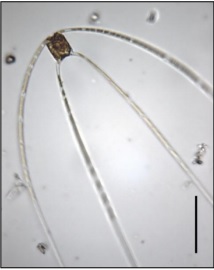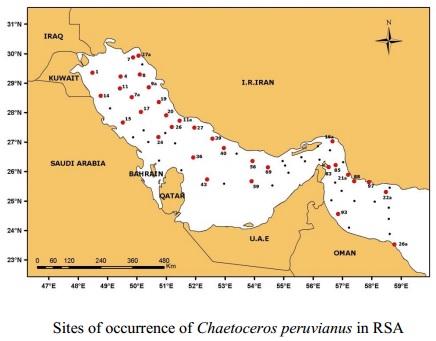Chaetoceros peruvianus Brightwell
 Division: Chromophyta
Division: Chromophyta
Class: Bacillariophyceae
Order: Biddulphiales
Suborder: Biddulphiineae
Family: Chaetocerotaceae Ralfs in Pritchard
Genus: Chaetoceros Ehrenberg
Scientific name: Chaetoceros peruvianus Brightwell

Species: peruvianus
Synonyms:
Chaetoceros peruvio-atlanticum Karsten; Chaetoceros convexicornis Margin; Chaetoceros peruvianum var. currens H. Péragallo.
References:
Pavillard, 1925: p. 42, Fig. 67; Hustedt, 1930: p. 670-673, Fig. 379-381; Allen and Cupp,1935: p. 135-136, Figs. 56, 57; Cupp, 1943: p. 113, Fig. 68 a-c; Crosby and Wood, 1958: p. 518, Pl. 34: 49; Hendey, 1 964: p. 123, Pl. IX: 3; Simonsen, 1974: p. 31; Priddle and Fryxell, 1985: p. 40-41; Ricard, 1987: p. 203, Fig. 448.
Description:
Cells usually solitary, seldom building short chains, 16- 32 µm broad. Valves elliptical; valves unlike, the upper rounded, lower flat, both with similarly constructed valve mantles which vary greatly from one-sixth to equal the length of the apical axis; on girdle-band margin with hollow channel-like groove of varying size, but always very distinct. Setae of upper valve, arising from near center, turning sharply and running backward in more or less wide, outwardly convex curves after short basal region. At the end, more or less divergent to convergent. Setae of lower valve springing from near margin, slightly convex toward outside, more nearly parallel to chain axis than those of upper valve. At end, more or less divergent or even convergent; all setae strong, 3-5 µm thick, four-sided, with strong spines, striated, 20-22 striae in 10 µm (Cupp, 1943).
Harmful Effect:
Non-toxic bloom-forming species; no harmful incidents have been reported, but species may be regarded as potentially harmful due to its morphology (Hansen et al., 2001).
Taxonomic Remarks:
Cells of this species may be different in size. Smaller specimens have been described as separate species form - Chaetoceros peruvianus Brightwell f. gracilis (Schröder) Hustedt.
Dimensions:
Apical axis 18-22 µm; pervalvar axis 25-27 µm.
Distribution:
Oceanic; in south temperate to warmer seas.
Sites of occurrence in RSA:
In Winter 2006 Cruise, this species was frequently observed at various sites (refer sites map),often in large numbers; maximum abundance (1.4*10^4 cells/l) was associated with Kuwaiti waters in the northwestern part of the inner RSA (St. 14). Species has been previously reported from the inner RSA (Simonsen, 1974) and from Kuwaiti waters (Al-Yamani et al., 2004; Al-Kandari et al., 2009).



